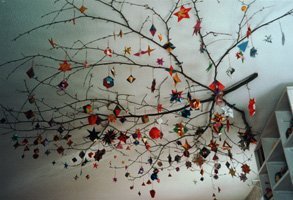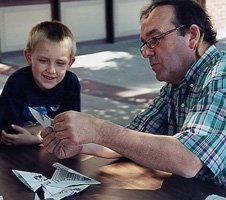About Town
with
Virginia Ray
Greenfield Recorder
Paper folding art: complex simplicity
Every teen-ager knows how to fold a piece of paper in half lengthwise and then again, and then in the middle...and then again...and maybe just once more, until that last end can be tucked into the awaiting triangular pouch.
Then, voila - the "note" passed a zillion times a day in and out of classrooms everywhere.
What these note-passers may not know is that with as many folds, a bit more concentration and some direction, he or she can make an exquisitely delicate bird, cube, star or strawberry.
And you won't need glue, or pencils or anything but maybe a pair of tweezers and a creasing tool.
And then you'd be making Origami, the Japanese art of paper sculpture.
 Jean-Claude Lejeune of Bernardston, has been folding Origami for 20 years. Today he's holding a large-scale "paperweight," designed by American origami master Robert Neale, which he has folded with 15 sheets of paper to make as many "modules" and put them together.
Jean-Claude Lejeune of Bernardston, has been folding Origami for 20 years. Today he's holding a large-scale "paperweight," designed by American origami master Robert Neale, which he has folded with 15 sheets of paper to make as many "modules" and put them together.
"If I used more paper, I could go on and on " says Lejeune. "Each module is simple. If you look at it, you wouldn't think anything of it. But when you put them together, you have this miracle."
Born near Versailles in France, Lejeune and his wife Jacqueline moved to New England and ultimately Franklin County in the mid-eighties. A professional photographer, Lejeune specializes in black and white stock photography, most of which is used in college textbooks or advertisements, including some for American Airlines. His work has appeared in The Economist, Newsweek and USA Today.
He won the Grand Prix given by the French Federation of Postcard Publishers at the Postcard Salon in Nantes, France as well as the first prize in the photography division for other photographs already published as postcards and sold world-wide by Art Unlimited in Amsterdam.
He also dabbles in rubber stamp art
For Lejeune, Origami has been a way to relax.
'When you have a medium through which you make a living, sometimes you look for something else," he says. "I wanted something where I didn't have to sell my work, something strictly for the pleasure of it, not to pay the rent or anything else. I do exactly what I want and the idea behind that is to try to connect in a personal way. "
Lejeune has used geometric modular designs to decorate a tree at the Arts Council of Franklin County's "Forest of Treasures" Christmas tree exhibit.
The tree is so bright and full it hardly even needs lights. Lejeune says he folded the Origami pieces that decorate his tree over 20 years. While he's used them on his own tree at home in combination with other kinds of decorations, this Year, with a new kitten in the family, he's not sure he'll chance enticing tiny claws with the exquisitely folded papers.
(This is how we solved the problem!!!! Click on the image to see larger view)
 He himself lights up when talking about Origami, and his first visit years ago with master design creator Neale, who moved from Northampton to Vermont.
He himself lights up when talking about Origami, and his first visit years ago with master design creator Neale, who moved from Northampton to Vermont.
"I went to his house and saw this and it blew my mind," says Lejeune of the "paperweight" model. "I was so obsessed with what I was looking at, I didn't hear a word he said, it was so beautiful. This, with a square sheet of paper!"
Neale, who also creates magic tricks, was once a theologian, not an unusual occupation for Origami masters, who are also often mathematicians and computer scientists as well, says Lejeune.
"Most people think Origami is for kids, but when you reach that level, we're not talking about children, he says of the master creators of the designs that others fold. "Being near these people, it's like standing near those electrical transmission lines. You can actually hear their
brains crackle.
But not every, Origami shape is created geometrically, like the stars and sunbursts and cubes, there are animal and bird designs. Lejeune says there are two kinds of folders, those who visualize the design in their minds and those who intuitively fold.
'You can create a shape with 90 modules, or, as one person did, one with 900," says Lejeune. "According to the number of modules, you have a very specific shape."
Today, Origami designs have become so complex through masters' continued work, that places like the Origami Society in New York now give prizes for the simplest model.
"Even a one-inch star can be made of six sheets of paper," says Lejeune.
Part of what excites Lejeune about Origami is its simplicity.
"I find this the most democratic craft there is," he says. "The only tools you need are a pair of tweezers and a bone creaser. The total cost is about $10. And you don't need to use Origami paper, you can use recycled newspaper. Someone could go to the dump and get paper. The only thing you need is to start with a paper cut into a perfect square.
Lejeune has folded an incredible box - with no glue or other way of affixing anything, just folding - from the pages of a book in a design created by one of the few female Origami design creators, Tomoku Fuse.
But folding skill like this doesn't happen overnight, as any of us who have attempted one of those little swans can attest to.
"When folding the bird for the first time, if it looks awful it is not a problem," he says. "Every first model I make is terrible. When you first start, you don't know where you are going, like taking a trip, you don't know the road. The second time, when you know the road, it's going to be a very different trip.
Lejeune says "mastering the model" by following instructions is key to successful Origami.
Lejeune, who has taught Origami folding to children in Northfield and Warwick, says he tells them that "if they are quiet, they'll hear the paper tell them what to do."
they'll hear the paper tell them what to do."
"It's a very Zen-like craft," he says. "The most difficult thing is to follow the instructions, which are linear. And you have to go to a three-dimensional thing. The brain is active - the kids, they want to finish before they start. You have to restrain the brain from taking over.
"Always I get in trouble when I let the brain come in. When you cannot follow the instructions, that's when there are problems, and that's why there are millions of books sitting on shelves gathering dust. ",
Now, says Lejeune, there are a number of videotaped instructions that he thinks will help potential folders see better what they are trying to do than a drawing or photograph portrays.
Lejeune is clearly transported when he talks about Origami, kind of like Stephen Hawking explaining the Big Bang theory. But there's much that is practical about Origami as well, like the medium of paper and the lack of a need for expensive tools. And one more thing.
"That's what's nice about Origami, " says Lejeune as he picks up his box filled with creatures and shapes painstakingly crafted. "It's light. You don't get a hernia carrying stuff around."
Kind of just makes you want to blow the dust off that book, cut a square, and start folding.
Jean-Claude's favorite origami models
Newest newspaper article
Returned to the origami splash page